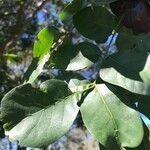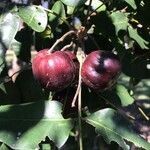Tree up to 36(-48) m high and 75 cm ø. Buttresses sometimes present, up to c. 2½ m high. Bark dark-grey or grey-brown, flaky, fissured. Young branchlets usually puberulous, pubescent, or tomentose, glabrescent. Leaves with 3-6 pairs of leaflets, rachis 4-30 cm, petiole 3-12 cm, both puberulous, pubescent or tomentose, sometimes glabrescent, or glabrous. Leaflets elliptic-oblong to-lanceolate, sometimes ovate, or obovate-oblong, 3½-13½ by 2½-6cm; glabrous, sometimes sparsely or moderately hairy especially on the midrib and nerves on both surfaces (rarely only on the lower surface); with hairy domatia; base unequal, cuneate, or decurrent, sometimes obtuse; apex acute, acuminate, sometimes obtuse, or cuspidate; nerves 8-11 pairs, veins reticulate; petiolules ½-l cm, the terminal one 1-4 cm. Inflorescences: ♂ up to 30 cm long, branches up to 8½ cm long, many-flowered; ♀ rather simple, usually short, 2-3½ cm long, rarely up to 15 cm long, few-flowered; floral bracts triangular, ¼-1½ mm long; pedicels very short, up to c. ⅔ mm, articulated. Flowers greenish yellow. Calyx lobes suborbicular, ½-¾ mm long. Petals ovate-oblong, 1¾—3 by l-2½ mm. Stamens 2-3 mm, usually those opposite the calyx lobes longer than those opposite the petals; anthers ½-⅔ mm, thecae free at the lower ⅓-½, connective distinct, brown or dark brown, sometimes slightly prolonged beyond the thecae. Sterile or imperfect stamens in ♀ ⅔-l mm. Disk 1½-l¾ mm ø. Ovary subglobose, c. 1 mm ø, glabrous; styles c. ½ mm. Sterile pistil in ♂ ⅓-l mm. Drupe broadly obovoid, l½—1¾ by 1½-2 cm, red to dark brown when ripe, smooth and glabrous, obtuse or truncate at the top, the lower ⅔ lengthwise ridged, with distinct scars of styles at the apical end; endocarp rather smooth, slightly smaller than the dried drupe. Seed ¾-1¼ by ⅓ cm.
More
A medium sized deciduous tree. It can grow to 20-45 m high. It spreads 8-15 m wide. It can have buttresses. The bark is hard, grey-brown and cracked. Young growth is usually hairy. The leaves are compound. They are 10-18 cm long. The leaflets are on opposite sides of the stalk. New growth is red-brown. There are 5-11 leaflets and they are 4-10 cm long by 2-6 cm wide. The male flowers are in groups 15 cm long. The female flowers are in groups 5 cm long. The flowers are 0.8 cm across. They are white. The fruit are small and purple. They are 3-4 cm across. They have a thin acid pulp and a large irregular seed. The fruit occur singly or in bunches in the axils of leaves. They contain 5-12 seeds in a woody shell. The flesh is edible. The flesh can be white or purple.
Tree to 20 m high. Branchlets pubescent to glabrous. Leaflets mostly 5–11, lanceolate, elliptic or ovate, acute, acuminate or obtuse, often asymmetric, pubescent to glabrous, mostly 4–10 cm long and 2–6 cm wide; base acute, obtuse or attenuate, often unequal-sided; secondary veins mostly 8–10 pairs, often with pilose pocket-domatia; lateral petiolules 2–6 mm long; terminal petiolule 10–30 mm long. Calyx lobes ovate to suborbicular, 0.6–1 mm long. Petals ovate, 1.7–3.8 mm long. Male flowers: anthers 0.7–0.9 mm long; filaments 1.3–2.3 mm long. Female flowers: ovary 2.5 mm diam.; styles 1 mm long. Fruit depressed-obovoid, 2–2.5 cm long, 2–3.8 cm diam., dark purple.




